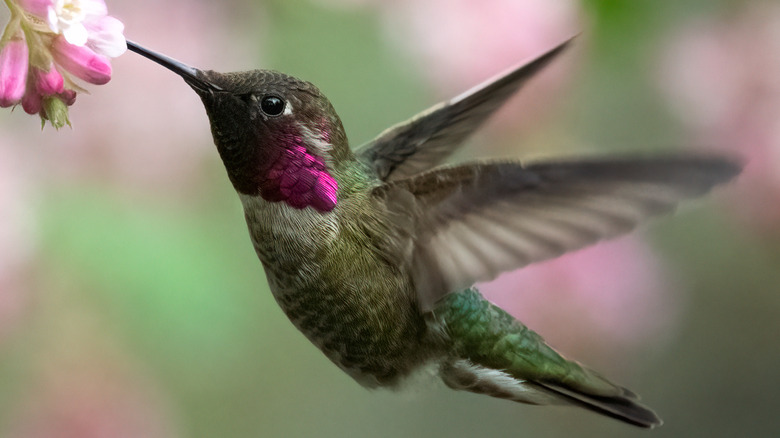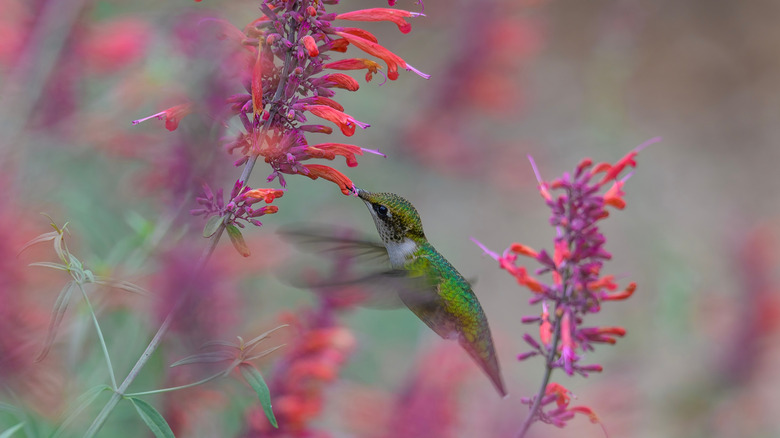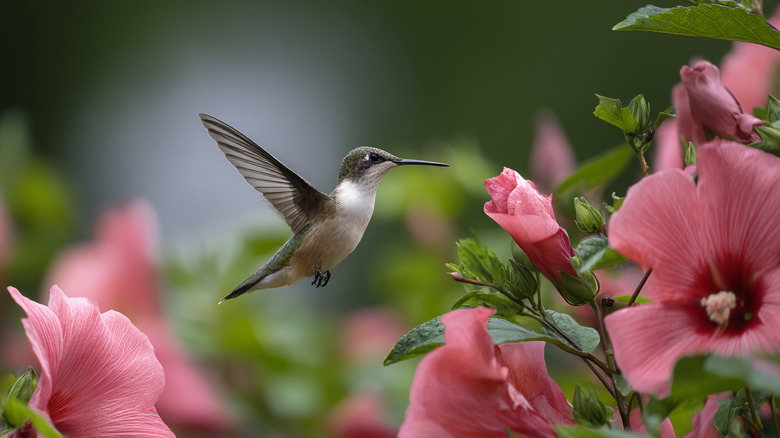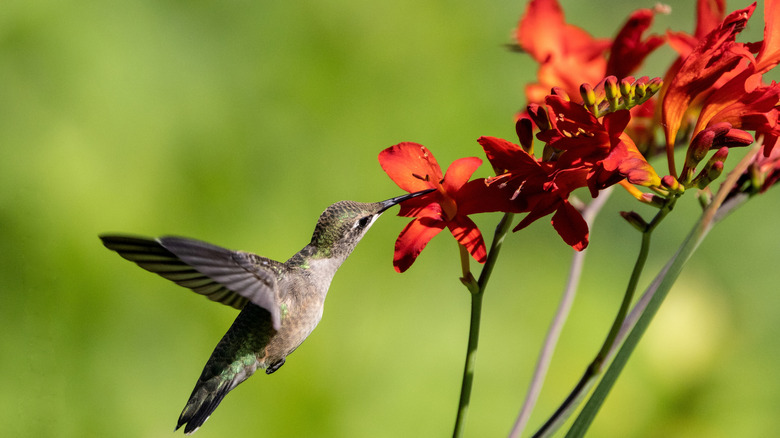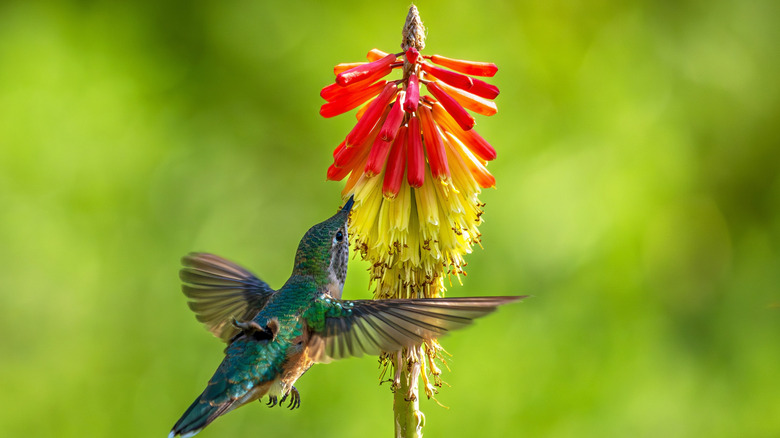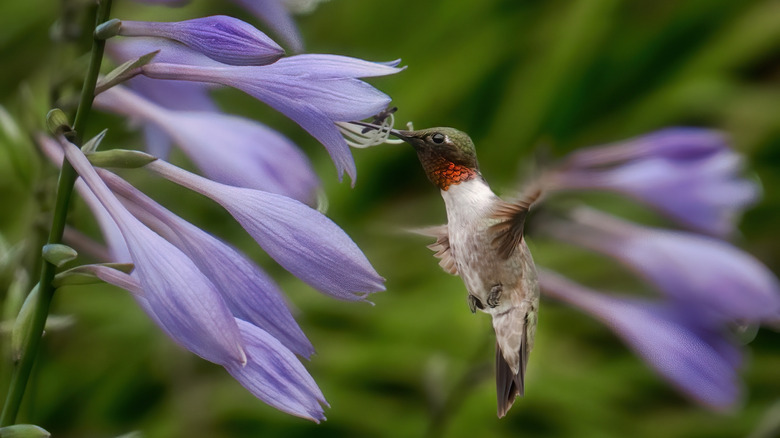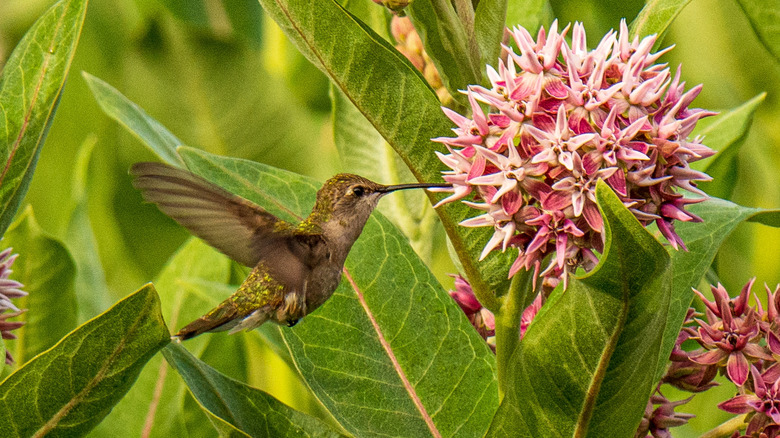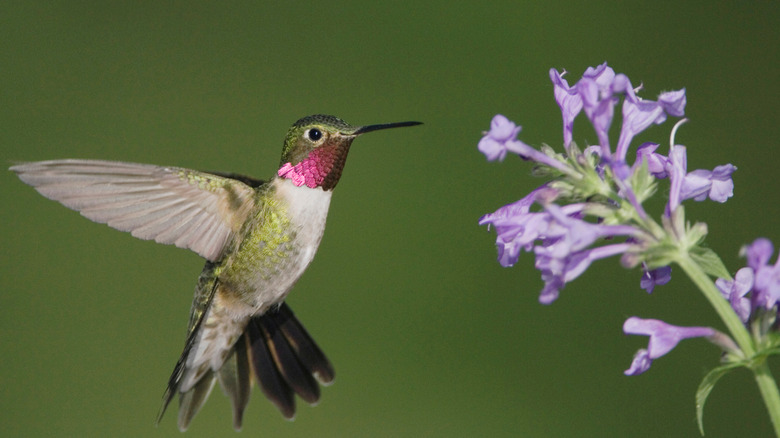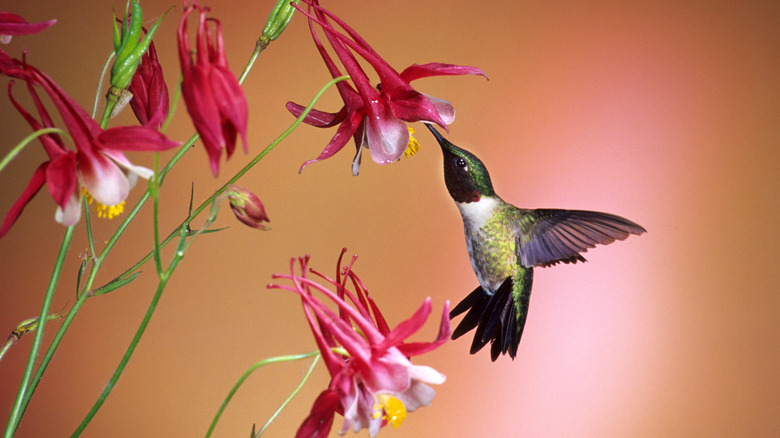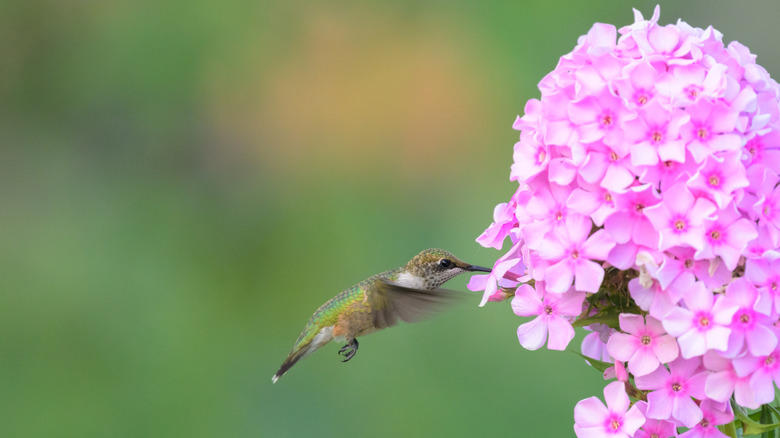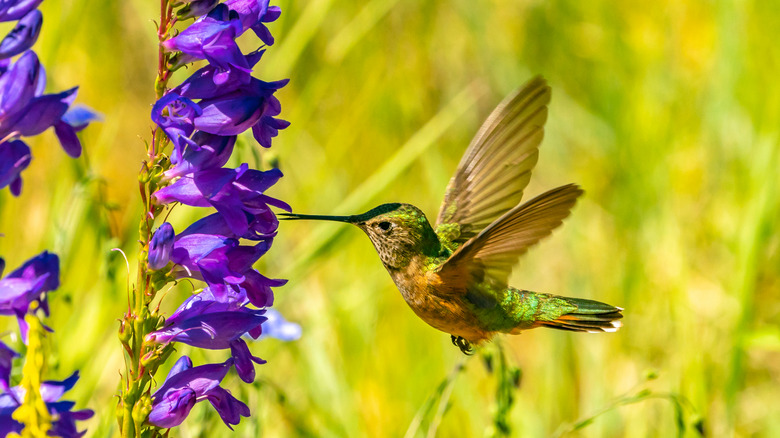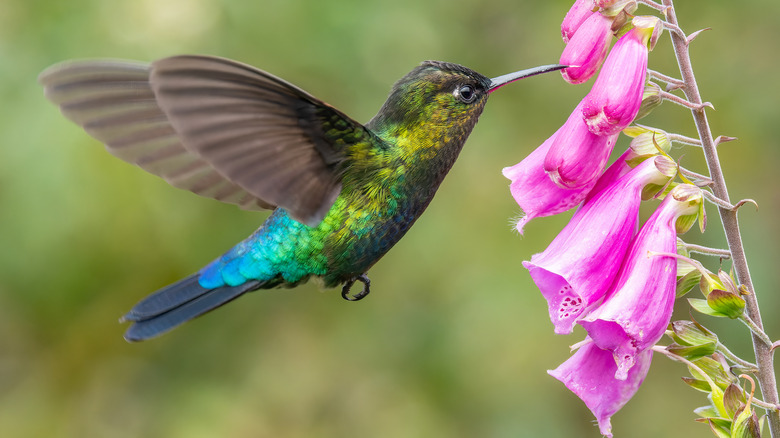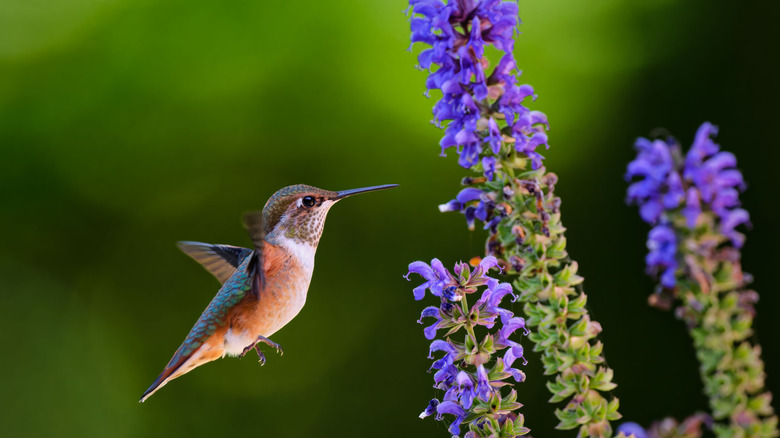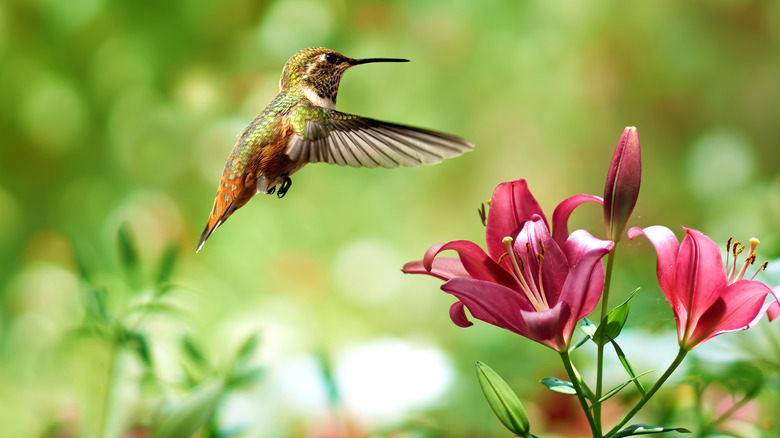13 Beautiful Perennials That Hummingbirds Love
Many kinds of perennial flowers can transform your space into a hummingbird haven and keep these feathered friends coming around. As a professional gardener, I try to choose plants that will bloom from spring through fall to keep the pollinators fed and happy and bring biodiversity to the gardens of my clients. These perennial plants and shrubs are surefire hummingbird attractors, and all are fairly easy to grow.
The number one feature of plants that attract hummingbirds is nectar. This is a sweet, nutritious liquid produced by blooming flowers and is a crucial part of the hummingbird diet. Hummingbirds use their powerful wings to stay aloft while they hover around plants to sip nectar, requiring plenty of energy. Their long pointed beaks allow them to access the nectar inside tubular flowers as well as flatter flower surfaces. Hummingbirds also like to have a sense of safety, as their small size makes them vulnerable to predators, so having some taller perennials and shrubs helps create cover for them and for songbirds in the garden.
Although the common lore is that hummingbirds are mainly attracted to red flowers, the truth is they're more concerned about nectar than about color. That's why there are a few purple and blue flowers in this list, and many hummingbird favorites come in a wide range of colors (like penstemon, hummingbird mint, and phlox). But red flowers do tend to lure these shy birds closer, where they will explore their feeding options, so it's a good idea to add a few red blooms to your hummingbird garden.
Hummingbird mint
The fragrant, summer-blooming perennial known as hummingbird mint (Agastache) is also called anise hyssop, thanks to the licorice-like scent of its blooms. It's wonderful for attracting many pollinators, especially honeybees and hummingbirds, and has a lovely cottage garden look with its fuzzy spikes of colorful flowers. Hardy in USDA zones 3 to 8, it's not fussy about soil but does like full sun. There's a wide range of cultivars in a rainbow of colors, from tall options like the rosy pink 'Ava' that grows up to five feet to compact types like the pale purple 'Little Adder' that tops out at 18 inches tall.
Rose of Sharon
These well-loved shrubs produce large, colorful flowers from July through September. The large stamens produce plentiful pollen and nectar, attracting many pollinators, including hungry hummingbirds. Hardy in USDA zones 5 through 8, the cold-tolerant rose of Sharon (Hibiscus syriacus) grows into a woody perennial shrub that increases in size each year and can reach up to twelve feet tall and six feet wide, providing great shelter for songbirds. Prune in early spring to control shape and size, or plant in a row for a flowering hedge. Some varieties reseed freely in the garden.
Crocosmia
Crocosmia plants, also known as montbretia, are in the iris family. The flowers look like gladiolas but are smaller, on tall, gracefully arching stems that bloom in mid- to late summer. The bulbs increase reliably over time, so you can divide them every three to four years. Hummingbirds love their bell-like shape, bright colors in shades of red, orange, and yellow, and plentiful nectar. Most varieties are hardy in USDA zones 6 through 9, like apricot-colored 'Gold Dust,' but I've grown the bright red 'Lucifer' cultivar for years in zone 5, and it's very cold hardy and robust.
Torch lily
This unusual looking flower is a popular perennial for the sunny pollinator garden. The torch lily (Kniphofia), also known as the red hot poker flower (though not all varieties are red), has slender, bell-like, pendulous flowers that hummingbirds enjoy sipping nectar from. They're mainly hardy in USDA zones 5 to 9, though some are only cold hardy to zone 6, depending on the cultivar. They range in height from 30 inches, like 'Flamenco' in bright yellow-orange, to up to five feet tall, like the lime green 'Lady Luck.'
Hosta
Some gardeners tend to deadhead the flower stems of hostas before they bloom, but letting them flower will attract pollinators, including hummingbirds, who love their tubular shape and abundant nectar. With so many hosta varieties available, there's a wide range of flower sizes and colors. 'Royal Standard' has large, fragrant white flowers that burst forth in mid- to late August, while 'Time in a Bottle' has chartreuse leaves and dark purple flowers. But hummingbirds will happily visit them all! Be sure to add some hostas — hardy in USDA zones 3 through 9 — to your shade area for their hummingbird-attracting benefits.
Milkweed
Milkweed is a great pollinator plant and attracts butterflies (especially Monarch butterflies, for whom it is their main food source), bees, moths, and hummingbirds. Many kinds of milkweed are native to the United States, and hummingbirds will feed on just about all of them. Common milkweed (Asclepias syriaca) is hardy in USDA zones 3 through 9. It tends to like dry meadow habitats, but will reseed in gardens frequently. It grows three to five feet tall and produces pale pink flowerheads.
Flowering catmint
Flowering catmint (Nepeta faassenii) is a sturdy perennial hardy in USDA zones 4 through 9. It likes sunny gardens and forms large clumps with long spikes of pale violet-blue flowers. It has a pleasant minty fragrance that deters mosquitoes, and the flowers attract many pollinators, including honeybees, butterflies, and hummingbirds. There are cultivars in a variety of sizes and with color variations of blues, purples, and even white. 'Walker's Low' and 'Cat's Pajamas' are both fairly short at up to 14 inches high, while 'Six Hills Giant' grows up to three feet tall.
Columbine
Columbines are a great perennial for spring color that will light up the shady spots in your garden. Hummingbirds are said to be most attracted to the native Eastern Red columbine (Aquilegia canadensis), but other columbines also attract pollinators, including hummingbirds. Columbines are super hardy through USDA zones 3 to 9, they're easy to grow, and they reseed freely in the garden. They will often hybridize and create new color variations, so be sure to plant a mix of colors.
Tall phlox
There are several types of phlox, but the one most attractive to hummingbirds is tall garden phlox (Phlox paniculata), which blooms from mid- to late summer. There are many new hybrids available in compact sizes, but I prefer the taller heirlooms like lavender 'Katherine' or two-toned pink 'Flamingo' because the flowers are more fragrant. Hummingbirds will be drawn to their nectar regardless, and phlox adds wonderful color to the partial shade garden. Give these perennial clumps — hardy in USDA zones 4 to 8 — some space for air circulation to help prevent powdery mildew on leaves.
Penstemon
Penstemon, also known as beardtongue, is a great perennial for the pollinator garden and comes in a nice assortment of colors, including white, pink, red, purple, and blue. The flowering flower spikes may grow up to three feet tall or more, depending on the variety, and they are mainly hardy in USDA zones 3 through 9. Hummingbirds love the tubular, nectar-rich flowers. These tough perennials like a dry, well-draining soil that's not too rich, and they're drought-tolerant. Once established, they increase reliably and provide a lovely bed of cottage garden beauty with soft spikes of color.
Foxgloves
It seems there's not a bell-shaped flower that hummingbirds don't love, and foxgloves are no exception. These biennials add drama to the partial shade garden: the tall stems are loaded with colorful flowers, some with fetching spots inside. From charming heirloom varieties to newer hybrids, foxglove colors include white, yellow, pink, peach, and magenta, and they range in size from compact at 12 inches high to very tall at five feet or more. Hardy in USDA zones 4 through 9, they like a loamy, moist soil and will often reseed in the garden, giving you blooms every year.
Woodland sage
One of the most common flowering perennial salvia plants chosen by gardeners is Salvia nemerosa, also called common woodland sage or meadow sage. These plants, hardy in USDA zones 4 through 8, have tall flower spikes in shades of blue and purple, as well as some white and pink. The herby fragrance deters mosquitoes but attracts beneficial pollinators, including hummingbirds, who skillfully extract nectar from the tiny flowers. 'May Night' is a popular cultivar, with bright purple flower spikes that grow 18 to 24 inches tall. Deadhead the spent flower spikes to encourage reblooming.
Lilies
Hummingbirds love all kinds of lilies, with their vivid colors, cup-shaped flowers, and abundant nectar. Lilies planted from bulbs, including Asiatic lilies, Oriental lilies, trumpet lilies, and various hybrid varieties, bloom from mid- to late summer. Asiatic lilies come in a range of heights — from 12 to 30 inches — while Oriental lilies may grow to five feet or taller. Some lilies are vulnerable to red lily beetles, a destructive pest, but there are non-toxic ways to get rid of them. Daylilies are not vulnerable to pests and will also attract hummingbirds.
